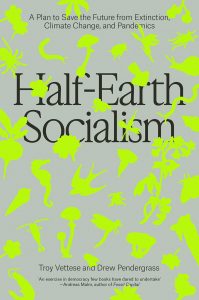In Half-Earth Socialism: A Plan to Save the Future from Extinction, Climate Change and Pandemics, Drew Pendergrass and Troy Vettese set out a vision of how we can avoid a dystopian future by stabilising the environment and simultaneously working towards a just society. The book reorients the dominant values, priorities and politics of current environmental approaches that have been fuelled by capitalist thought, writes Hema Vaishnavi Ale.
Half-Earth Socialism: A Plan to Save the Future from Extinction, Climate Change and Pandemics. Drew Pendergrass and Troy Vettese. Verso. 2022.
 Experiments in solar geoengineering, in an attempt to generate a global cooling effect, are now being funded by billionaires such as Bill Gates. A spectrum of scientists warns against pushing such experiments as we do not yet know and understand the catastrophe such measures could cause when deployed on a large scale.
Experiments in solar geoengineering, in an attempt to generate a global cooling effect, are now being funded by billionaires such as Bill Gates. A spectrum of scientists warns against pushing such experiments as we do not yet know and understand the catastrophe such measures could cause when deployed on a large scale.
Half-Earth Socialism: A Plan to Save the Future from Extinction, Climate Change and Pandemics, authored by Drew Pendergrass and Troy Vettese, begins by painting a dystopian future set in 2047, where solar radiation management is used to control global warming. The costs of such geoengineering technology soon catch up in the form of disruption to global weather systems and irreversible carbon lock-ins that prevent transition to low-carbon alternatives.
Stemming from a utopian tradition, Half-Earth Socialism is a thought experiment for the decades leading up to 2047, revealing the inadequacy of current strands of environmentalism that are predicated on outsourcing politics to the market. The concept of ‘Half-Earth’ is taken from entomologist EO Wilson, whose research has shown the need to rewild half of the planet to staunch the haemorrhaging of biodiversity. Half-Earth Socialism takes this concept forward. The book outlines how various measures pushed by the market and its ‘high priests’ – the neoliberals – will fail to prevent a global ecocide by the mid-century, which marks the centennial of their movement’s birth and its subsequent intellectual, political and economic hegemony.
As the book lays out the inevitable dystopian future facing us as a result of the current global measures to combat climate change, the authors also bring out the possibilities of how this can be avoided. Half-Earth Socialism strongly argues that despite the deteriorated state of the biosphere, there is still time to reverse its decline and work towards the creation of a just society.

Image Credit: Photo by CHUTTERSNAP on Unsplash
The first chapter sets out the philosophical foundations for a new eco-socialism based on the unknowability of nature, tracing the texts that have shaped the epistemological frameworks of current environmental thought. The authors engage with key texts by G. W. F. Hegel (The Spirit of Christianity and Its Fate), Thomas Malthus (Principle of Population) and Edward Jenner (An Inquiry into the Causes and Effects of the Variolæ) to highlight their contribution: namely, ‘Hegel’s Prometheanism; Malthusianism; and Jennerite ecological scepticism’. Hegel’s text is used to establish how the humanisation of nature happens through the process of labour; Malthus’s influence on economics, demography and population ecology is illustrated; and through Jenner’s text, the notion that diseases are the result of unnatural domination of animals by humans is established. Together, these three texts ‘represent discrete epistemologies based on what can be known and controlled: nature, demography, or the economy’.
The authors outline the pitfalls of the humanisation of nature and the structure of the society that has caused current environmental crises. They emphasise the need for epistemic humility to deal with phenomena as complex as climate change. The second chapter takes forward the principle developed in the first: the authors envisage linking ‘food, land, ecology, and politics within a single analytical frame’. Through a critique of solutions put forth by the current regime, which the authors dub demi-utopias – including bioenergy carbon capture and sequestration (BECCS), nuclear power and Wilson’s colonial ‘Half-Earth’ – the chapter outlines the goals of half-earth socialism, which are rooted in preventing the Sixth Extinction, practising ‘natural geoengineering’ and creating a fully renewable energy system.
The authors devote an entire chapter towards planning, getting a sense of material goals as well as the possibility of organising production and consumption without the market. They draw on influences including Soviet cybernetics and mathematics, Chile’s ‘Cybersyn’ programme, meteorology and integrated assessment models (IAMs) to propose alternative schemes rooted in democracy and centralised planning.
In the last chapter – a page from potential utopian socialist fiction – the authors engage with the quotidian life of half-earth socialism. The chapter imagines and constructs a neighbourhood in half-earth socialist society, set in 2047, where the authors look at what life would be like without the threat of unemployment, how central planning and local decision-making are possible, the possibility of rewilding while cohabiting with wildlife and economic co-ordination without a market in place.
The authors critically engage with neoliberalism and dedicate a chunk of the book to debunking current environmental solutions such as nuclear power, geoengineering, green growth and carbon capture storage. The book uses this critique to call for a theoretical and organisational revision of the Left and environmental movements to take on the neoliberals. However, there is a lack of rigorous theoretical engagement with both the foundational aspects of capitalism and the ideas put forth by eco-socialism. Even as the authors cite Cuba’s Período Especial in the 1990s as bearing a close resemblance to half-earth socialism, their interpretation seems confined to the time period of Cuba’s revolution. This argument inspires much-needed discussion about Cuba’s journey, its circumstances, questions of scale, social relations and feasibility that go far beyond the book’s focus. Proposing Cuba’s journey as a normative path of eco-socialism for other countries seems difficult to visualise if one were to follow Haldane’s principle ‘On Being the Right Size’, which questions modes of converting large economies and countries to socialism.
In spite of its analysis taking inspiration from early-twentieth-century polymath Otto Neurath’s idea of pseudorationality, which rejects utilitarian pleasure, energy and labour time, the book nonetheless proposes central planning and programming as the foundation of a half-earth socialist society. This contradicts their rejection of current capitalist society’s foundations in pseudorationality, even as the authors emphasise that the crux of the problem of deploying linear programming is not simply mathematical but epistemological.
The authors strongly argue for the need to agree on the details of what the utopia might look like, agreeing that speculation is a vital political act. Yet, even as they attempt to critique Wilson’s ‘Half-Earth’ for its colonial structure, the book’s lack of scope for discussing its demographic and geographical attributes does not allow us to address our historical reality of unequal responsibility. While details are not vital components of envisioning utopias, the book leaves much space for questioning the fundamental idea of state control, the web of bureaucracy and the redtape-ism that currently dictates inequality and marginalisation.
The idea of half-earth socialism is still rooted in a productionist framework, promoting its underlying universalising agenda through an eco-socialist structure. Such privileging of the global renders the local absent and trivial for constructing a utopian society. This utopian thought experiment has not left space for the imagined futures of the Global South and indigenous societies. One wonders, who is half-earth socialism for?
The book seeks to reorient the dominant values, priorities and politics of current environmental approaches that have been fuelled by capitalist thought and it serves as a guide to utopian thought experiments. What Half-Earth Socialism does is revive the utopian socialist tradition which the authors believe has been marginalised by the ‘scientific socialism’ of Marxism. In reviving this tradition, the reader is left pondering questions about detail, scope, relevance and, most importantly, half-earth socialism’s embedded notions of justice.
- This review first appeared at LSE Review of Books.
Please read our comments policy before commenting.
Note: This article gives the views of the author, and not the position of USAPP – American Politics and Policy, nor of the London School of Economics.
Shortened URL for this post: https://bit.ly/3zopfEq
About the reviewer
Hema Vaishnavi Ale – Transitions Research
Hema Vaishnavi Ale is a climate and STS associate at Transitions Research. She is an ethnographer by training and her area of work focuses on climate politics and low-carbon transitions. She has an MPhil in social anthropology from IIT Hyderabad, India.



